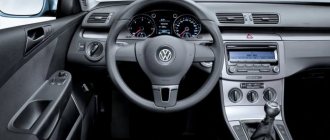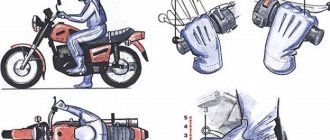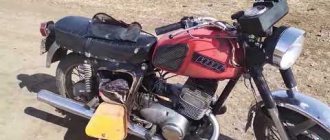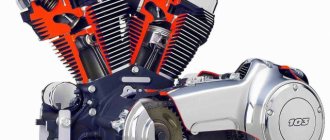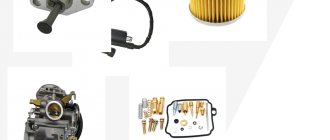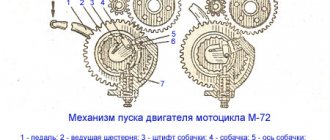Shifting gears in a manual transmission should be easy and quiet, regardless of whether the engine is running. In general, the engine is connected to the gearbox through a single unit - the clutch. It is with this that the difference in ease of switching is associated. There is one exception to this rule, which will be mentioned later.
Mechanism of interaction between the engine and the gearbox
The torque created by the car engine is removed and transmitted further from the flywheel. The flywheel is usually installed at the rear end of the crankshaft and is securely attached to it with several bolts. The bolts are equipped with special fixing belts in the threaded areas or are installed on an anaerobic retainer. Problems with fastening are extremely rare and are associated with gross mistakes by inattentive or unscrupulous servicemen.
The flywheel is a massive steel part with a machined end surface during manufacturing, along which the front friction lining of the clutch driven disc operates. When the clutch is engaged, the driven disk itself is tightly pressed to the flywheel by a powerful diaphragm spring of the drive disk. The spring, working surface and drive plate housing form the clutch basket. The basket is attached to the flywheel with several bolts around the perimeter of the casing.
The driven clutch disc is located between the flywheel and the drive disc, sometimes called the pressure disc. It consists of two friction linings, respectively to the flywheel and to the pressure plate, a damping device and a splined hub that slides freely along the splines of the gearbox input shaft.
When you press the pedal through a mechanical or hydraulic drive, the release bearing moves along the input shaft of the gearbox. The basket spring compresses and ceases to exert pressure on the driven disk. Zero force on the disc linings will result in zero friction between the flywheel and the linings. The primary shaft of the box, connected by splines to the disk hub, will stop its rotation. In such a situation, engaging a gear in the box is no different from the situation when the engine is not running.
The exception mentioned above is another connection between the engine and the gearbox. The front end of the input shaft rests on a bearing pressed into the end of the crankshaft. The friction in a working bearing is insignificant, and it is not able to spin the shaft when the working clutch is depressed. If rotation is difficult due to bearing wear, the shaft may continue to rotate, and the gearbox synchronizer will have to overcome the resulting parasitic torque with its internal friction. Shifting into gear will be difficult.
We recommend: How to choose tires for a car?
Difficulty shifting due to clutch fault
A sign of such a malfunction will be easy engagement of the gear when the engine is off and difficulty when trying to engage first or reverse gear with the car stationary with the engine running. Possible causes may be the following malfunctions.
- Incomplete clutch release due to problems with the drive. It is possible that the hydraulics may become airy, the mechanical drive adjustments may be disrupted, or the shape of parts may be distorted, for example, worn rods or a bent release bearing fork.
- Warping of the surfaces of friction pairs in the clutch. Happens when parts overheat. Both clutch discs and the flywheel can take on a wave-like shape. At the same time, it is not possible to completely retract the pressure plate; the clutch, as they say, “leads.”
- Exfoliated fibrous material from the linings got into the gaps between the driven disk and the driving surfaces.
- It is difficult to move the disk hub along the splines of the input shaft; the disk jams and continues to rub against the flywheel, although the force has already been removed from it.
- The clutch basket spring is deformed and the pressure plate operates skewed.
- The driven disk was stuck to the flywheel after the car had been parked for a long time.
Transmission problems
Ultimately, any malfunctions in the box lead to difficulties when switching. But this manifests itself already while the car is moving. That is, again with the engine running.
Most often the problem is caused by a faulty synchronizer. This simple device is designed, due to internal friction, to equalize the relative speeds of rotation of gears that engage in mesh. At the same time, due to the same friction, it wears out itself. It all ends with the fact that without grinding and great effort, it will not be possible to drive the gears into engagement. Treatment is to replace the synchronizer assembly. Together with the clutch and gear of a specific transmission.
There may also be problems with the switching mechanisms. For example, with forks. They rub along the annular grooves of the couplings and, despite the special very hard coating, also wear out over time. The transmissions first begin to fail, and then a complete failure occurs.
There are other causes of transmission strikes, but their occurrence can be delayed by the simple procedure of regular oil changes. You should not blindly believe the factory claims that oil is poured there for life. It may be so, but everyone will still want to extend this life. The oil ages and becomes dirty. By the end of its life, the cloudy slurry drained from there can hardly be called oil.
We recommend: Is it possible to flush the cooling system with Coca-Cola or citric acid?
Automatic boxes
As strange as it may sound, theoretically there are no fundamental differences between automatic transmission and manual transmission. Everywhere there are friction pairs (clutches or sets of wet discs), gear transmissions and an oil bath. Therefore, the diseases are the same, as are the measures for repair and prevention. There is no need to allow power slipping during sudden starts, skip oil changes and overheat the mechanisms. It’s just that this is even more relevant for automatic transmissions. The mechanisms here are more delicate, the oil requirements are high, and the cost of repairs is many times higher.
The situation is aggravated by the presence of complex hydraulic automation. Gear shifting here is controlled by a set of valves, which are vitally important to work with clean oil. What a manual transmission can tolerate, an automatic transmission will not tolerate. And instead of a clutch, a torque converter works here, which generates a lot of heat. The properties of the oil deteriorate sharply when heated. The presence of oil radiators does not always help. And to reassemble the box you will need a highly paid specialist with the required qualifications.
Problems with switching to automatic transmission
Shifting problems with automatic transmissions are not uncommon. Problems with the automatic machine arise for several reasons.
- backstage malfunction . This mechanism is the most problematic in old-type automatic transmissions. To eliminate the malfunction, the unit will need to be replaced. In most cases, it will be necessary to dismantle the gearbox for these purposes;
- insufficient oil level . The presence of lubricant leaks on the automatic transmission housing may indicate wear of the sealing gaskets, which are not difficult to replace yourself. After this, you need to change the oil in the box. Also, owners of cars with an automatic transmission are recommended to visually inspect the gearbox for oil leaks at least once every 2000 km;
- problems with the transmission control unit can ultimately cause the automatic transmission to completely lock up. To fix the problem, you will need to replace the failed mechanism and thoroughly inspect the electrical part of the gearbox.
Important! To solve problems with automatic transmission, it is recommended to conduct computer diagnostics of transmission faults.
Troubleshooting methods
Once the source of the problem has been found, you can begin to eliminate the causes of the malfunction.
If the problem is in the engine
The simplest cause of problems when shifting gears can be a leak of brake fluid, which is the working fluid for the clutch. If there is insufficient lubrication in the clutch hydraulic system, it will not engage fully. Therefore, first check the fluid level in the car's tank. If the level is low, check for leaks, repair defects and bleed the clutch. When the fluid level is at the normal level, the clutch elements should be inspected.
Clutch problems
The clutch consists of three main components:
- disk;
- release bearing;
- baskets (pressure disk).
Malfunctions of these units can lead to problems with gear shifting when the engine is running.
The fact that the bearing is failing may be indicated by the appearance of a rustling or distinct hum when the engine is running and the clutch pedal is pressed to the floor. When you release the pedal, the noise should stop. When the bearing completely jams, it will no longer be possible to operate the gear shift mechanism. In this case, the unit will need to be replaced.
A faulty basket can also cause the problem. This often results from critical wear of the petals. In this case, the basket stops performing its functions when heated, and it is not possible to completely remove the pressure disk. Therefore, after removing the box, it is necessary to carefully inspect the basket for deformations and other defects. If the condition of the unit is not satisfactory, it should be replaced with a new one.
Finally, the last reason for problematic gear shifting associated with the clutch is wear or deformation of the disc and the friction linings on it.
Important! After the failed elements are replaced, during assembly you should center the box and also bleed the clutch.
The problem is at the checkpoint
The most common cause of a gearbox malfunction is wear of the synchronizers. You may have previously been warned about this by a characteristic crunch when changing gears. Synchronizers that smooth out the angular speeds of the shafts are usually made of copper and are therefore subject to wear.
Much less often, the gearbox shafts themselves can fail. In this case, a separate transmission may not be included. The degree of wear and the need for replacement is also determined after dismantling and disassembling the transmission.
Important! To eliminate malfunctions that have arisen in the box, major repairs may be required, which are not cheap and do not happen quickly. Therefore, you need to be prepared for the fact that your car will be delayed in service.
However, you should not immediately think about the bad. Sometimes a problem with gear shifting can be caused by a lack of oil in the gearbox. Loud noise while driving or a metallic grinding sound in the box may indicate insufficient oil level. If there is a complete lack of oil, you will not be able to change gears at all: the synchronizers will not function properly. Changing the gearbox oil is recommended every 60-80 kilometers.
In addition to checking the oil level in the gearbox, you will also need to inspect the unit body for damage and the absence of lubricant leaks through the gaskets and seals.
Manual transmission: What you need to know when shifting gears
The result is premature wear of the clutch disc. In order to keep the car from rolling on an incline, you need to depress the brake pedal. In order to start, of course, you will have to press the clutch and smoothly press the gas, releasing the clutch. In this case, you will reduce the load time on the clutch basket and release bearing. You can also hold the car by maintaining certain engine speeds, catching a certain moment when you release the clutch and press the gas.
We recommend: How to make a heated steering wheel with your own hands?
Surprised? But in fact, this advice is really very important, because having a habit of leaving your hand on the gear shift knob can lead to premature transmission failure. If you most often leave your hand on the gearbox when stopped in a traffic jam or at a traffic light, then the first gear of the manual transmission suffers the most. Remember that by placing your hand on the gearshift knob, you create extra pressure on it, which is transferred to the gearbox. As a result, excess pressure on the handle can lead to unfree shifting of the desired gear. This can damage the gear shift knob as well as the transmission itself.
Why haven't they abandoned manual transmissions yet?
Now, probably, many newcomers thought - “oh yes, “mechanics”, but who needs it, but now everyone drives an automatic transmission, and in general its days are numbered.” This is not entirely true, because this option has a lot of fans and real advantages, I won’t list them all, after all, we already thought - which is better than an automatic transmission or a manual transmission , but I will list some of the most significant ones:
- Price. As a rule, this option is 40 - 80,000 rubles cheaper than its automatic counterpart
- Fuel consumption, no automatic option has yet come close to it (but already quite a bit)
- Strength
- Simplicity of design
- Withstands heavy loads (accepts large torques )
- Temperature (difficult to overheat)
That is why this option is now used on many trucks, heavy SUVs, and many passenger cars. In general, it is premature to write off this unit, and now a version is being developed without a clutch pedal, that is, something like a semi-automatic transmission is switched manually, but there are no pedals.
For what reasons do interruptions occur?
There can be many reasons why gears do not shift when the engine is running. However, all of them, in one way or another, are connected with the two most important units of the car - the engine or gearbox. In case of serious damage, you should contact a good car service.
If the problem is in the gearbox, it will need to be removed for further disassembly and troubleshooting. If the problem is with engine components, they may need to be replaced. However, there are cases when, to eliminate a malfunction, it is enough to carry out preventive maintenance: removal, lubrication and careful adjustment of the components.
Fork
Now let's look at more complex malfunctions due to which the gears do not engage when the engine is running. UAZ is also susceptible to this breakdown, so you should not neglect the fork. Thus, on most rear-wheel drive and all-wheel drive vehicles, the gears are engaged hydraulically. When the driver presses the clutch pedal, the release piston is activated, which pushes the fluid under pressure. As a result, the fork is moved to the side and the disk is disconnected. Inspect the condition of the plug itself and check the tightness of the system. If the level in the reservoir constantly drops (by the way, a “brake fluid” is used for the clutch), the clutch slave cylinder boot may have torn. Because of this, we get incomplete compression of the fork. The latter also sometimes breaks off, especially on GAZelles. This thing looks like this:
This indicates that the plug was not of the best quality and should be replaced. When purchasing such critical items, it is not the price that is important, but the quality. You should not give preference to cheap analogues. Repairs can take a lot of your time and effort. On front-wheel drive vehicles, replacing the fork requires dismantling the gearbox.
Why is it difficult for the gear lever to shift on a manual transmission?
- After the desired shift has occurred, you need to release the clutch pedal, there is no need to hold it! Because there is increased wear on the clutch disc
- It is advisable to move in the gear that corresponds to a given speed, this relieves both the engine and the gearbox from unnecessary loads, the best is 4th gear, also called “direct”, in this connection the minimum number of gears and all two shafts are occupied (in bypassing the intermediate). This reduces wear on the manual transmission
- A lower gear should be engaged when the speed decreases, just like an upshift when accelerating.
The main causes of malfunctions Mechanics, like automatic ones, are designed to transmit and change torque from the power unit to the wheels, and this must be done comfortably and dynamically. That is, the car must accelerate as quickly as possible and do this without any “jerks” of prohibitive engine speeds (so that it does not “growl like a victim”) and, if possible, have sufficient traction forces.
Drive and clutch cables
For rear-wheel drive models (VAZ 2101 - 2107), the gears are engaged hydraulically. That is, when you press the clutch, the fluid pushes the piston, which in turn pushes the clutch fork, which retracts the disc. For front-wheel drive models (VAZ 2108 - 2115), there is no hydraulic connection; everything is done here by mechanics, or rather by the clutch cable, which is connected to the pedals. If your slave cylinder leaks on a rear-wheel drive car or the cable breaks on a front-wheel drive car, the car will not engage in gear. The “fork” simply won’t work. We just check and replace damaged parts.
Engine mounts
I personally have never had this happen, but many people write that this is a fairly common problem. Actually, the problem is this: the engine hangs on cushions, the gearbox is connected to it (manual transmissions, by the way, have their own cushions). It happens that the fastening breaks, or it unscrews. The engine or “box” may sag, the scenes may break, or they will hit something.
THEN there is another not very serious problem - these are pillows! If the programs don’t turn on, then we watch them.
These malfunctions, AS I THINK, ARE NOT PROBLEMS AT ALL! Anyone can identify them on pits or lifts, and this is done quite quickly. Personally, I came across rockers and cables, using the example of a VAZ, a clutch cable.
However, if you have checked everything, and the gears do not engage with the engine running. Then it’s worth looking at the box itself and the accompanying attachments. Let's move on to complex faults.
Manual transmission bearings
And the last thing that could be the bearings - although they are very strong in the box, sometimes they also “stick”. The box will work like a tractor, especially when warm.
In any case, if you have problems in the gearbox itself, then this is an expensive repair. It is also better to entrust it to professionals, because the gearbox is a very complex mechanism.
As you can see, there are quite a few reasons, but in fairness it is worth noting that mechanical transmissions are a fairly reliable unit; they themselves break down quite rarely, especially if you change the transmission fluid on time and pour a branded one of very good quality.
If the gears do not engage, then these are most likely “attached” problems, starting from the rockers and cables, ending with the basket, clutch disc and flywheel.
Now let’s take a look at a short video version of my article.
And that's ALL for me! I think the information will definitely be useful, read our AUTOBLOG.
( 10 votes, average: 4.70 out of 5)
What to do if you have difficulty engaging reverse gear
If you have difficulty engaging reverse gear, you need to follow a certain algorithm of actions:
- If you feel that the gear has not reached the end, you need to release the clutch little by little.
- Fully depress the clutch and a few seconds later move the selector to the reverse position.
- Depress the clutch, set it to neutral and release it.
- Immediately after this, press the pedal and engage reverse gear.
You can also try to turn it on through another: for example, turn on the fourth, and then the rear one.
A transmission may shift poorly for a variety of reasons. You can determine the cause of the malfunction and eliminate it yourself, but it is better to contact a specialist. In the latter case, the risk of making a mistake is minimal.
